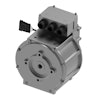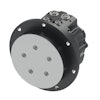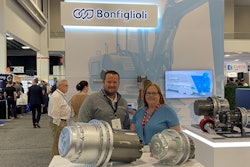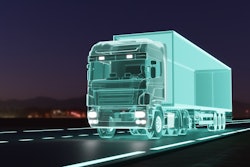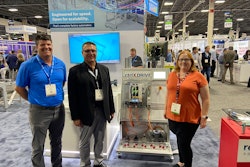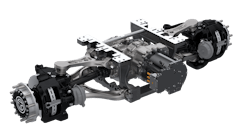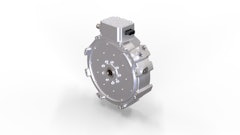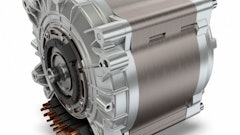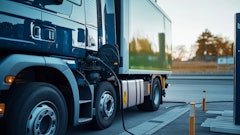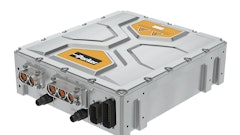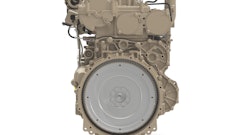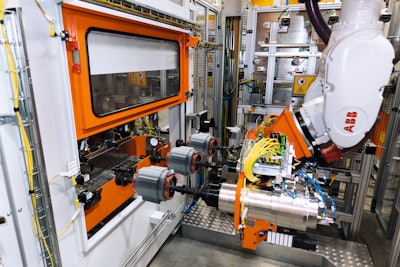
It’s no secret that most light vehicle OEMs have committed to fully electric fleets within the decade. Regardless of one’s opinion of the viability, performance or economics of electric vehicles, it is clear the world is inevitably transitioning from combustion engines to electric power. This movement is already being felt in the construction equipment field and will only become more and more prevalent in the coming years.
In an already short period of time, electric motors for passenger vehicles have evolved and matured to offer amazing balances of speed, acceleration and efficiency. Obviously, heavy construction and agriculture equipment have many more, and different, requirements. Speed is replaced by torque. Acceleration is replaced by power. But the beauty of electric motors is that one can make them perform differently by changing voltages and currents. Just as noteworthy, there are many motor design characteristics that can be made to maximize performance metrics.
In fact, there are several motor types that are well-suited for the construction industry. Synchronous permanent magnet motors (think wheel loaders) and asynchronous Induction motors (think fork trucks) are well-understood and quite commonly used. Of course, there are variations to these motors. Synchronous reluctance motors, for example, can give the performance of the permanent magnet motor, without the costly magnets. No one motor is best for all applications. Each has its own advantages, depending on the use.
Whatever the type of motor the vehicle requires, OEMs are increasingly facing difficult decisions to produce their own motors or purchase them from Tier I suppliers. Uncertainty in the electric market, as well as rapidly changing technologies, make this decision extremely difficult and fraught with very expensive risks.
This article will present basic, but critical, considerations for make-buy decisions of electric motors and strategies for in-house production that adapt to fluctuating demand and changing technologies.
Sourcing Options
All traction motors have three principle assembly commodities: the stator, the rotor, and the complete motor assembly (housing, bearings, gears, etc.). Among all OEMs, there are three primary sourcing strategies for motors:
1. Purchase the complete motor assembly from a Tier I producer. This can be the OEM’s own design or an off-the-shelf unit of the supplier’s own design.
2. Purchase the rotor and stator from a Tier I supplier and assemble them into the motor assembly yourself. The stator and rotor can be produced to your own design or designed by the supplier or other third party.
3. Design and assemble your own stator, rotor, and motor.
Deciding to purchase your motors or manufacture them in-house really starts with the OEM’s knowledge and experience of designing efficient electric motors. For many OEM’s who are starting to venture into electric powertrains, they often lack the proper resources to confidently design their own motors. For them, the only clear choice then is to purchase finished drive units from a reputable Tier I supplier. Normally, the OEM can work with the Tier I supplier to customize the performance metrics to meet the application.
If the OEM is fortunate enough to have a team of experienced motor designers, then any sourcing strategy can be pursued, and the commercial side of the decision becomes the primary driver.
Make or Buy?
In-sourcing motor production is capital intensive. Depending on the type of motor, stators are easily the most expensive and difficult component to produce. For this reason, every consideration must be made for the design of the stator. In order of investment, a coil-wound stator requires the least investment, a continuous hairpin stator is the next most expensive and a hairpin stator is the most capital-intensive solution. That said, traditional hairpin stators dominate most design choices and offer a number of functional benefits.
Likewise, capital investment in rotor assembly is greatly dependent on the type of rotor. Generally, induction rotors use axially-inserted conductor rods and are the most economical rotors to assemble. Permanent magnet motors, on the other hand, depend on many individually-placed magnets in multiple laminate stacks. Often, there could be hundreds of these magnets in a rotor. The methodology to secure the magnets (interference fit, adhesive, or overmolding) also has a large impact on the capital investment. Overall, permanent magnet rotors require a larger investment than induction rotors. However, the choice of induction or permanent magnet rotor should be driven by the application and not the costing.
Besides the design of the stator and rotor, the second critical consideration is the required production demand. Demand should not be thought of as simply maximum annual units. The projected fluctuations year-to-year are an equally important consideration to make the most efficient investment decisions. “If there are some years with a drop in demand, will I be comfortable paying for capital equipment that is not fully utilized those years?” In these cases, some OEMs will employ a hybrid sourcing approach. That is, they in-source the stable portion of the forecasted demand and contract a Tier I to produce the overflow demand in the peak years.
In-House Production Challenges
Considering changing market demands makes it challenging to right-size production systems. Some motor manufacrurers offer multiple production line strategies that fit OEM needs regardless of the required capacity. New OEM entrants first purchase low volume systems. These systems have proven beneficial for several reasons:
- They become a training lab for the customer.
- The customer can produce its own prototypes.
- They have just enough capacity to produce any special niche motors.
Because of the motor differences when compared with diesel engines, for many OEMs in the automotive industry who have already embraced e-mobility, the technology change in the early years was highly disruptive to the workforce. Manufacturing engineers who only knew cylinder head machining were now being asked to assemble permanent magnet rotors. Assembly line technicians were now asked to run very complicated stator production equipment. The learning curve for the workforces was measured in years. Therefore, expect major inefficiencies in the early stages.
The market is changing fast and the transition to electrified construction equipment is inevitable, whether we are ready for it or not. By doing a self-appraisal of your resources and skill levels in this new technology, you can prepare yourself to make the best decisions not only for the types of motors to use, but also where and how to secure their production. Today’s Tier I motor suppliers are highly competent and offer reliable supply in unreliable times. They remain a primary strategy for most OEMs at some level. In-sourcing affords greater security against supply chain disruptions and allows OEMs to economically adapt to product design evolutions. But, as most OEMs who are in the e-mobility world now have learned, the transition is very difficult. The rewards for that transition will be reaped, however.
Glenn Oshel is key accounts director, e-mobility, GROB Systems, Inc.

